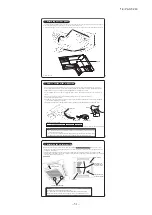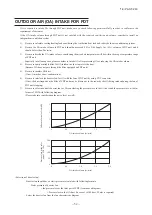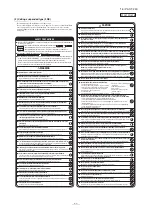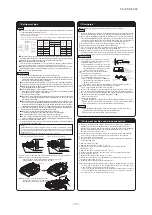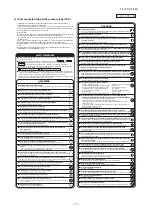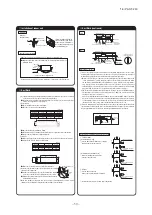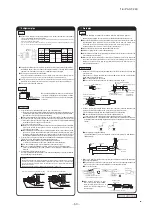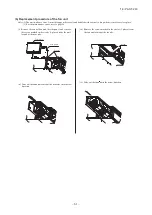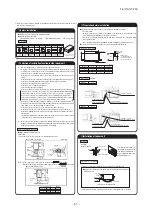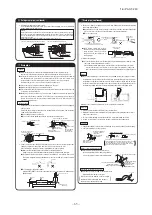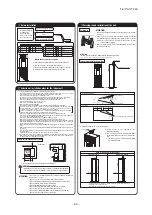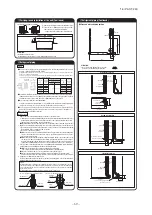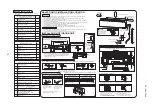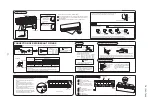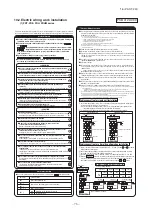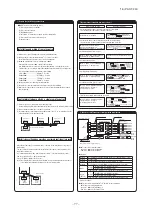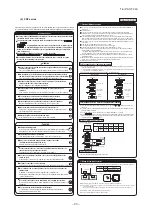
-
65
-
'16 • PAC-T-240
⑦
Drain pipe (continued)
3. Make sure to make descending slope of greater than 1/100 and do not make up-down bend
and/or trap in the midway.
●
Pay attention not to give stress on the pipe on the indoor unit side, and support and fix the
pipe as close place to the unit as possible when connecting the drain pipe.
●
Do not set up air vent.
●
When sharing a drain pipe for more
than one unit, lay the main pipe 100mm
below the drain outlet of the unit. In
addition, select VP-30 or bigger size for
main drain pipe.
4. Insulate the drain pipe.
●
Be sure to insulate the drain socket and rigid PVC pipe installed indoors otherwise it may
cause dew condensation and water leakage.
※
After drainage test implementation, cover the drain socket part with pipe cover (small
size), then use the pipe cover (big size) to cover the pipe cover (small size), clamps and
part of the drain hose, and fix and wrap it with tapes to wrap and make joint part gapless.
Drain up
●
The position for drain pipe outlet can be raised up to 600mm above the ceiling. Use elbows
for installation to avoid obstacles inside ceiling. If the horizontal drain pipe is too long before
vertical pipe, the backflow of water will increase when the unit is stopped, and it may cause
overflow of water from the drain pan on the indoor unit. In order to avoid overflow, keep the
horizontal pipe length and offset of the pipe within the limit shown in the figure below.
Otherwise, the construction point makes it same as drain pipe construction.
Drain test
1. Conduct a drain test after completion of the electrical work.
2. During the trail, make sure that drain flows properly through the piping and that no water
leaks from connections.
3. In case of a new building, conduct the test before it is furnished with the ceiling.
4. Be sure to conduct this test even when the unit is installed in the heating season.
Procedures
1. Supply about 1000 cc of water to the unit through the air outlet by using a feed water pump.
2. Check the drain while cooling operation.
Outline of bottom drain piping work
●
If the bottom drain piping can be done with a
descending gradient (1/50-1/100), it is possible to
connect the pipes as shown in the drawing below.
Uncoupling the drain motor connector
●
Uncouple the connector CNR for the drain motor as
illustrated in the drawing on the right.
Note: If the unit is run with the connector coupled,
drain water will be discharged from the upper
drain pipe joint, causing a water leak.
P.C. board
Insert water supply hose
for 20mm – 30mm to
supply water.
(Insert hose facing
toward bottom.)
Attached drain hose clamp
Drain
piping
Main
unit
Drain situation can be checked with transparent socket.
If the electrical work has not been completed, connect a convex
joint in the drain pipe connection to provide a water inlet.
Then, check if water leaks from the piping system and that
drain flows through the drain pipe normally.
Pour water into a convex joint
Remove grommet
Make sure to Install
it back after test.
Connecting port of top drain pipe
Insulating material
Transparent soft tube
(Prepare on site)
Rubber stopper (to be removed)
Connecting port of bottom drain pipes
(Outside diameter:20mm)
Standard hard polyvinyl
chloride pipes
(
)
600 max
295-325
100 or less
⑥
Refrigerant pipe (continued)
4. Refrigerant is charged in the outdoor unit.
As for the additional refrigerant charge for the indoor unit and piping, refer to the installation
manual attached to the outdoor unit.
Caution:
Refrigerating machine oil should not be applied to the threads of union or external surface of flare. It
is because, even if the same tightening torque is applied, the oil is likely to decrease the slide friction
force on the threads and increase, in turn, the axial component force so that it could crack the flare
by the stress corrosion.
Refrigerating machine oil may be applied to the internal surface of flare only.
Descending slope greater than 1/100
As wide as possible
(about100mm)
Supporting metal
Descending slope greater than 1/100
* Please confirm that the pipe doesn’t bend.
Air vent
No bump
No trap
Not touching the water
Trapped air will
generate noises.
VP-30 or bigger
1m~2m*
PJG012D008C
D
<
The case of using thicness of insulation is 10mm
>
<
The case of using reinfoced insulation
>
Pipe cover (Accessory)
Unit
Unit
Band
(Accessory)
Band
(Prepare on site)
Insulation (Prepare on site)
Pipe cover (Prepare on site)
Band
(Accessory)
The thckness of insulation is 10mm
⑦
Drain pipe
Caution
●
Install the drain pipe according to the installation manual in order to drain properly.
Imperfection in draining may cause flood indoors and wetting the household goods, etc.
●
Do not put the drain pipe directly into the ditch where toxic gas such as sulfur, the other harmful
and inflammable gas is generated. Toxic gas would flow into the room and it would cause
serious damage to user’s health and safety (some poisoning or deficiency of oxygen).
In addition, it may cause corrosion of heat exchanger and bad smell.
●
Connect the pipe securely to avoid water leakage from the joint.
●
Insulate the pipe properly to avoid condensation drop.
●
Check if the water can flow out properly from both the drain outlet on the indoor unit and the end
of the drain pipe after installation.
●
Make sure to make descending slope of greater than 1/100 and do not make up-down bend
and/or trap in the midway. In addition, do not put air vent on the drain pipe. Check if water is
drained out properly from the pipe during commissioning. Also, keep sufficient space for
inspection and maintenance.
Work procedure
1. Make sure to insert the drain hose (the end mode of soft PVC) to the end of the step part
of drain socket.
Attach the hose clamp to the drain hose around 10mm from the end, and fasten the
screw within 5mm left to the nut.
●
Do not apply adhesives on this end.
●
Do not use acetone-based adhesives to connect to the drain socket.
2. Prepare a joint for connecting VP-25 pipe, adhere and connect the joint to the drain hose (the
end made of rigid PVC), and adhere and connect VP-25 pipe (prepare on site).
※
As for drain pipe, apply VP-25 made of rigid PVC which is on the market.
●
Make sure that the adhesive will not get into the supplied drain hose.
It may cause the flexible part broken after the adhesive is dried up and gets rigid.
●
The flexible drain hose is intended to absorb a small difference at installation of the unit or
drain pipes. Intentional bending, expanding may cause the flexible hose broken and water
leakage.
●
As for drain pipe, apply VP25 (OD32).
If apply PVC25 (OD25), connect the expanded connector to the drain hose, with adhesive.
(Multi unit only)
Drain socket
Pipe cover (big) (For insulation)
(Accessory)
VP25 joint (Prepare on site)
VP25
(Prepare on site)
Pipe cover (small)
(For insulation) (Accessory)
Unit
Clamp (Accessory)
Pipe cover (small)
(For insulation)
(Prepare on site)
Drain socket
Metal plate
10mm
Hose clamp
Fasten the screw within
5 mm left to the nut.
Drain hose
Drain socket
Drain hose
Stage difflernce part
Drain hose
(Accessory)
Adhesion
295
ー
325mm
PVC25 (Prepare on site)
Elbow (Accessory)
(Multi only)
Drain hose
Indoor side
Insulation material
Insulation material
⑤
Duct Work (continued)
⑤
Duct Work
Connecting the air intake/vent ducts
①
Fresh Air Intake
[for air intake duct only]
○
Use the side fresh air intake hole, or supply
through a part of the suction duct.
[for simultaneous air intake/vent]
○
Intake air through the suction duct.
(the side cannot be used)
②
Air Vent
○
Use the side air vent hole.
(always use together with the air intake)
○
Insulate the duct to protect it from dew condensation.
①
A corrugated board (for preventing sputtering) is attached to the main body of the air-conditioner
(on the outlet port). Do not remove it until connecting the duct.
●
An air filter can be provided on the main body of the air-conditioner (on the inlet port). Remove
it when connecting the duct on the inlet port.
②
Blowout duct
●
Use rectangular duct to connect with unit.
Duct size for each unit is as shown below.
●
Duct should be at their minimum length.
●
We recommend to use sound and heat insulated duct to prevent it from condensation.
●
Connect duct to unit before ceiling attachment.
③
Inlet port
●
When shipped the inlet port lies on the back.
●
When connecting the duct to the inlet port, remove the air filter if it is fitted to the inlet port.
●
When placing the inlet port to carry out suction from the bottom side, use the following
procedure to replace the suction duct joint and the bottom plate.
●
Remove the screws which fasten the
●
Replace the removed bottom plate
bottom plate and the duct joint on the
and duct joint.
inlet port side of the unit.
●
Fit the duct join with a screw; fit the bottom plate.
●
Make sure to insulate the duct to prevent dewing on it.
④
Install the specific blowout duct in a location where the air will
circulate to the entire room.
●
Conduct the installation of the specific blowout hole and the
connection of the duct before attaching them to the ceiling.
●
Insulate the area where the duct is secured by a band for dew
condensation prevention.
⑤
Make sure provide an inspection hole on the ceiling. It is indispensable to service electric
equipment, motor, functional components and cleaning of heat exchanger.
①
If a duct is not provided at the suction side but it is substituted with the space over the ceiling,
humidity in the space will increase by the influence of capacity of ventilation fan, strength of
wind blowing against the out door air louver, weather (rainy day) and others.
a)Moisture in air is likely to condense over the external plates of the unit and to drip on the
ceiling. Unit should be operated under the conditions as listed in the above table and within
the limitation of wind volume. When the building is a concrete structure, especially immedi-
ately after the construction, humidity tends to rise even if the space over the ceiling is not
substituted in place of a duct. In such occasion, it is necessary to insulate the entire unit with
glass wool (25mm). (Use a wire net or equivalent to hold the glass wool in place.)
b)It may run out the allowable limit of unit operation (Example: When outdoor air temperature
is 35°C DB, suction air temperature is 27°C WB) and it could result in such troubles as
compressor overload, etc..
c)There is a possibility that the blow air volume may exceed the allowable range of operation
due to the capacity of ventilation fan or strength of wind blowing against external air louver
so that drainage from be heat exchanger may fall to reach the drain pan but leak outside
(Example: drip on to the ceiling) with consequential water leakage in the room.
②
If vibration damping is not conducted between the unit and the duct, and between the unit and
the slab, vibration will be transmitted to the duct and vibration noise may occur. Also, vibration
may be transmitted from the unit to the slab. Vibration damping must be performed.
Secure with a band, etc.
Blowout
duct
Air-conditioner main unit
Ceiling suriace
Suction grille
(Locality)
Suction hole
(marketed item)
(with air filter)
Inspection hole
Suction duct
(marketed item)
Blow outlet
Blowout duct
(optional or marketed item)
Bad example of duct work
Bad example of duct work
For ventilation
Louver to
outdoor air
(Pipe side)
(Pipe side)
Side fresh air intake hole
Air vent hole
Fresh air intake through the
suction duct
Fresh air intake through the
suction duct
(Pipe side)
Air vent hole
Fresh air intake through the
suction duct
⑥
Refrigerant pipe
Single type
Multi type
A
B
40-50
22-56
682
172
60-71
71-90
882
172
100-140
112-140
1202
172
A
B
UNIT: mm
●
Be sure to use new pipes for the refrigerant pipes. Use the flare nut attached to the product
or a nut compatible with JIS B 8607, Class 2.
Regarding whether existing pipes can be reused or not, and the washing method, refer to the instruction manual of the
outdoor unit, catalogue or technical data.
1) In case of reuse: Do not use old flare nut, but use the one attached to the unit or compatible with JIS B 8607, Class 2.
2) In case of reuse: Flare the end of pipe replaced partially for R410A.
●
Use phosphorus deoxidized copper alloy seamless pipe (C1220T specified in JIS H3300) for refrigeration pipe installation.
In addition, make sure there is no damage both inside and outside of the pipe, and no harmful
substances such as sulfur, oxide, dust or a contaminant stuck on the pipes.
●
Do not use any refrigerant other than R410A.
Using other refrigerant except R410A (R22 etc.) may degrade inside refrigeration oil. And air getting into
refrigeration circuit may cause over-pressure and resultant it may result in bursting, etc.
●
Store the copper pipes indoors and seal the both end of them until they are brazed in order to avoid any dust, dirt or
water getting into pipe. Otherwise it will cause degradation of refrigeration oil and compressor breakdown, etc.
●
Use special tools for R410A refrigerant.
Piping work
When conducting piping work, make sure to allow the pipes
to be aligned in a straight line for at least 250 mm, as shown
in the left illustration. (This is necessary for the drain pump
to function)
Work procedure
1. Remove the flare nut and blind flanges on the pipe of the indoor unit.
※
Make sure to loosen the flare nut with holding the nut on pipe side with a spanner and giving torque to the
nut with another spanner in order to avoid unexpected stress to the copper pipe, and then remove them.
(Gas may come out at this time, but it is not abnormal.)
●
Pay attention whether the flare nut pops out. (as the indoor unit is sometimes pressured.)
2. Make a flare on liquid pipe and gas pipe, and connect the refrigeration pipes on the indoor unit.
※
Bend radius of pipe must be 4D or larger. Once a pipe is bent, do not readjust the bending.
Do not twist a pipe or collapse to 2/3D or smaller.
※
Do a flare connection as follows:
●
Make sure to loosen the flare nut with holding the nut on pipe side with a spanner and giving
torque to the nut with another spanner in order to avoid unexpected stress to the copper
pipe, and then remove them.
●
When fastening the flare nut, align the refrigeration pipe with the center of flare nut, screw
the nut for 3-4 times by hand and then tighten it by spanner with the specified torque
mentioned in the table above. Make sure to hold the pipe on the indoor unit securely by a
spanner when tightening the nut in order to avoid unexpected stress on the copper pipe.
3. Cover the flare connection part of the indoor unit with attached insulation material after a gas
leakage inspection, and tighten both ends with attached straps.
●
Make sure to insulate both gas pipes and liquid pipes completely.
※
Incomplete insulation may cause dew condensation or water dropping.
●
Use heat-resistant (120 °C or more) insulations on the gas side pipes.
●
In case of using at high humidity condition, reinforce insulation of refrigerant pipes.
Surface of insulation may cause dew condition or water dropping, if insulations are not
reinfoced.
Caution
D
Protruding
dimension
Flare die
d
mm
6.35
9.52
12.7
15.88
19.05
For R410A Conventional tool
Pipe dia.
Min. pipe
wall thickness
Protruding dimension for flare, mm
Rigid (Clutch type)
Flare O.D.
Flare nut
tightening torque
0
ー
0.5
0.7
ー
1.3
D
mm
8.9
ー
9.1
12.8
ー
13.2
16.2
ー
16.6
19.3
ー
19.7
23.6
ー
24.0
N·m
14
ー
18
34
ー
42
49
ー
61
68
ー
82
100
ー
120
mm
0.8
0.8
0.8
1
1.2
Refrigerant pipe
250mm
(Section where attached
in a straight line)

